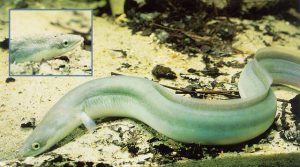How eels navigate to the Sargasso Sea
 The migration of European eels (Anguilla anguilla) between freshwater habitats in Europe and North Africa and their spawning ground in the Sargasso Sea is one of the unsolved mysteries in animal navigation. Scientists have speculated that the eels may use the Earth’s magnetic field as a guide during their 6000 kilometer trip, and an article published today by Durif et al. strongly supports this idea.
The migration of European eels (Anguilla anguilla) between freshwater habitats in Europe and North Africa and their spawning ground in the Sargasso Sea is one of the unsolved mysteries in animal navigation. Scientists have speculated that the eels may use the Earth’s magnetic field as a guide during their 6000 kilometer trip, and an article published today by Durif et al. strongly supports this idea.
To test the ability of eels to orient using a magnetic field, the authors used a carefully controlled laboratory setting, in which they eliminated other potential orientation cues, including odors, vibrations, light, and sounds. They also created an artificial magnetic field, the same strength as the Earth’s magnetic field, which could be oriented in different directions. Turning the artificial magnetic field between test runs helped rule out the possibility of the eels using other orientation cues.
The authors found that the eels consistently oriented in a particular direction with respect to magnetic north and that the eel’s particular orientation varied with water temperature. Below 12 oC, which is the temperature range associated with eel migration, the eels oriented in the direction they had been transported from the holding tank to the testing tank. This also corresponded with the direction of increasing water temperature. Above 12 oC, the eels oriented at right angles to the direction they had been transported, which the authors speculate might reflect foraging behavior during times of the year the eels are not migrating.
Thus, eels seem capable of using the Earth’s magnetic field as a navigational guide. They also seem to integrate this information with other cues, such as water temperature, to determine their direction of movement.
While these results provide some insight into how eels navigate to their spawning ground, other mysteries about eel migration remain, including where the spawning ground in the Sargasso Sea is precisely located. For further reading about eel migration, see another paper published in PLOS ONE in October, in which Béguer-Pon et al. tagged adult American eels (Anguilla rostrata) to map their migration to the Sargasso Sea but instead learned something about porbeagle shark predation.
Image credit: Steffen Zienert (http://nas.er.usgs.gov/queries/factsheet.aspx?SpeciesID=308)
Citations: Durif CMF, Browman HI, Phillips JB, Skiftesvik AB, Vøllestad LA, et al. (2013) Magnetic Compass Orientation in the European Eel. PLoS ONE 8(3): e59212. doi:10.1371/journal.pone.0059212
Béguer-Pon M, Benchetrit J, Castonguay M, Aarestrup K, Campana SE, et al. (2012) Shark Predation on Migrating Adult American Eels (Anguilla rostrata) in the Gulf of St. Lawrence. PLoS ONE 7(10): e46830. doi:10.1371/journal.pone.0046830
